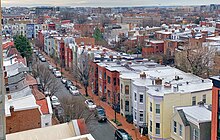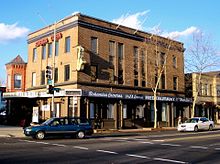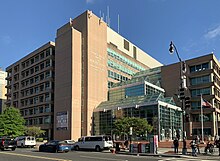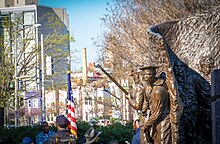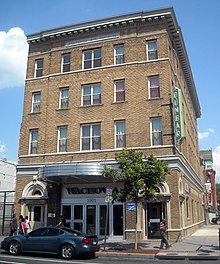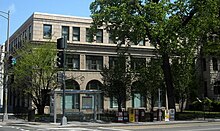
Adams Morgan, commonly abbreviated as AdMo, is a neighborhood in Washington, D.C., located in Northwest D.C. Adams Morgan is noted as a historic hub for counterculture and as an arts district. It is also known for its popular entertainment district and culinary scene, centered on both 18th Street and Columbia Road.

U Street station is a rapid transit station on the Green Line of the Washington Metro in the U Street neighborhood of Washington, D.C.

Mount Pleasant is a neighborhood in Washington, D.C., located in Northwest D.C. The neighborhood is primarily residential, with restaurants and stores centered along a commercial corridor on Mt. Pleasant Street. Mount Pleasant is known for its unique identity and multicultural landscape, home to diverse groups such as the punk rock, the Peace Corps and Hispanic Washingtonian communities.

Northwest is the northwestern quadrant of Washington, D.C., the capital of the United States, and is located north of the National Mall and west of North Capitol Street. It is the largest of the four quadrants of the city, and it includes the central business district, the Federal Triangle, and the museums along the northern side of the National Mall, as well as many of the District's historic neighborhoods.

Columbia Heights is a neighborhood in Washington, D.C., located in Northwest D.C. The neighborhood is an important retail hub for the area, as home to DC USA mall and to numerous other restaurants and stores, primarily along the highly commercialized 14th Street. Columbia Heights is home to numerous historical landmarks, including Meridian Hill Park, National Baptist Memorial Church, All Souls Church, along with a number of embassy buildings.

Logan Circle is a historic roundabout park and neighborhood of Washington, D.C., located in Northwest D.C. The majority of Logan Circle is primarily residential, except for the highly-commercialized 14th Street corridor that passes through the western part of the neighborhood. In the 21st century, Logan Circle has been the focus of urban redevelopment and become one of Washington's most expensive neighborhoods. Today, Logan Circle is also one of D.C.'s most prominent gay neighborhoods.

Shaw is a neighborhood of Washington, D.C., located in the Northwest quadrant. Shaw is a major entertainment and retail hub, and much of the neighborhood is designated as a historic district, including the smaller Blagden Alley-Naylor Court Historic District. Shaw and the U Street Corridor have historically have been the city's hub for African-American social, cultural, and economic life.

LeDroit Park is a neighborhood in Washington, D.C. located immediately southeast of Howard University. Its borders include W Street to the north, Rhode Island Avenue and Florida Avenue to the south, Second Street NW to the east, and Howard University to the west. LeDroit Park is known for its history and 19th century protected architecture. The community's diversity entices new residents to the community, as well as its close proximity to the Shaw–Howard University Metro station and many dining options.

14th Street NW/SW is a street in Northwest and Southwest quadrants of Washington, D.C., located 1.25 miles (2.01 km) west of the U.S. Capitol. It runs from the 14th Street Bridge north to Eastern Avenue.
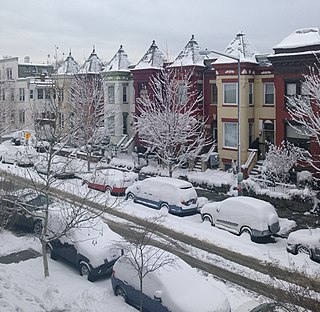
Bloomingdale is a neighborhood in the Northwest quadrant of Washington, D.C., less than two miles (3 km) north of the United States Capitol building. It is a primarily residential neighborhood, with a small commercial center near the intersection of Rhode Island Avenue and First Street NW featuring bars, restaurants, and food markets.

Lincoln Theatre is a historic theater in Washington, D.C., located at 1215 U Street, next to Ben's Chili Bowl. The theater, located on "Washington's Black Broadway", served the city's African American community when segregation kept them out of other venues. The Lincoln Theatre included a movie house and ballroom, and hosted jazz and big band performers such as Duke Ellington. The theater closed after the 1968 race-related riots. It was restored and reopened in 1994, and hosts a variety of performances and events. The U Street Metro station, which opened in 1991, is located across the street from the Lincoln Theatre.
The District of Columbia is a federal district with an ethnically diverse population. In 2020, the District had a population of 689,545 people, with a resident density of 11,515 people per square mile.

Twelfth Street YMCA Building, also known as Anthony Bowen YMCA, was home to the first African American chapter of YMCA, founded in 1853 by Anthony Bowen. It is located at 1816 12th Street NW in the U Street Corridor (Cardozo/Shaw) neighborhood of Washington, D.C. The building was reopened on February 20, 2000, as the Thurgood Marshall Center in honor of the first African American Associate Justice to serve on the United States Supreme Court. The Thurgood Marshall Center now serves as a community center for residents of the U Street Corridor and Shaw neighborhoods. The permanent organization of Phi Beta Sigma fraternity was established in the Bowen Room.

The Strivers' Section Historic District is a historic district located in the Dupont Circle neighborhood of Washington, D.C. Strivers' Section was historically an enclave of upper-middle-class African Americans, often community leaders, in the late 19th and early 20th centuries. It takes its name from a turn-of-the-20th-century writer who described the district as "the Striver's section, a community of Negro aristocracy." The name echoes that of Strivers' Row in Harlem, a New York City historic neighborhood of black professionals. The district is roughly bounded by Swann Street and the Dupont Circle Historic District on the south, Florida Avenue and the Washington Heights Historic District on the north and west, and the Sixteenth Street Historic District on the east.
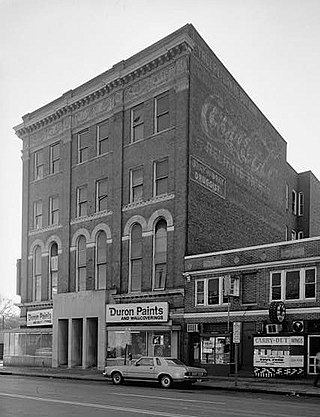
The True Reformer Building is an historic building constructed for the True Reformers, an African American organization founded by William Washington Browne. The building is at 1200 U Street, Northwest, Washington, D.C. in the U Street Corridor (Cardozo/Shaw) neighborhood. It was designed by John Anderson Lankford. The building was commissioned by the Grand United Order of True Reformers in 1902. It was dedicated on July 15, 1903.

The Whitelaw Hotel is a historic structure located in the U Street Corridor in Northwest Washington, D.C. It was listed on the National Register of Historic Places in 1993.

The Fourteenth Street Historic District is located in the Logan Circle and U Street Corridor neighborhoods of Washington, D.C. It was listed on both the District of Columbia Inventory of Historic Sites and the National Register of Historic Places in 1994. The area was then expanded on both lists in 2007.

Shaw Junior High School, now known as Asbury Dwellings, is a historic structure located in the Shaw neighborhood of Washington, D.C. It has been listed on the District of Columbia Inventory of Historic Sites and on the National Register of Historic Places since 2008.
The Black Renaissance in D.C. was a social, intellectual, and cultural movement in Washington, D.C. that began in 1919 and continued into the late 1920s.





